Milan is famous for its fashion and culture. It’s a great place to start a vintage clothing store. The city’s artistic vibe draws in people from all over. This makes it perfect for a boutique that sells unique, stylish clothes.
Vintage fashion is getting more popular. If you’re thinking of starting a store, now is a good time. This article will help you get started. You’ll learn how to open a vintage clothing store in Milan and get tips on vintage fashion.
Key Takeaways
- Milan is a prime location for opening a vintage clothing store due to its fashion-forward culture.
- Understanding vintage fashion trends is crucial for product selection and customer appeal.
- A well-structured business plan is essential for launching a successful boutique business.
- Location plays a key role in the success of your vintage store—evaluate districts and foot traffic.
- Effective marketing strategies, including social media engagement, can boost visibility and sales.
- Building a strong brand identity will help differentiate your store in a competitive market.
Understanding the Vintage Clothing Market in Milan
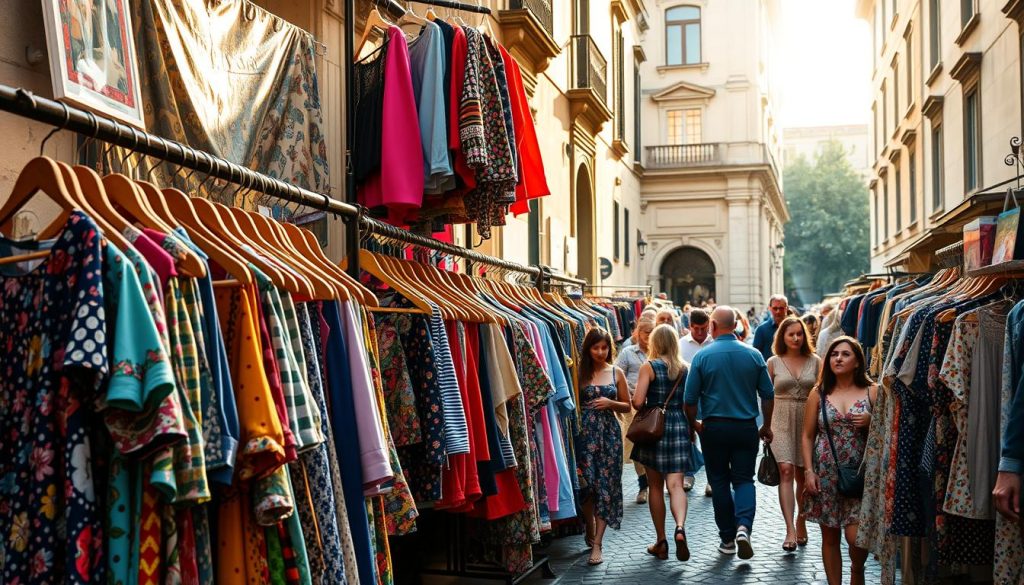
The vintage clothing market in Milan is booming. It attracts people with different tastes and interests. With more focus on sustainability, shops are changing what they sell. This shift is key for those wanting to succeed in this market.
Trends in Vintage Fashion
Vintage fashion is now all about being green. People want clothes with a story and brands that care for the planet. The latest trends include:
- The comeback of 90s and early 2000s looks, loved by the young.
- Upcycled and repurposed clothes, for those who care about the environment.
- Unique, one-of-a-kind items that help express personal style.
Target Demographics for Vintage Clothing
Knowing who buys vintage clothes helps shops plan better. In Milan, vintage shops appeal to:
- Young fashion lovers looking for something special.
- Older collectors who value genuine vintage items.
- Shoppers who prefer sustainable fashion options.
By understanding these groups, new businesses can better serve their customers. This way, they can thrive in the market.
Key Steps to Opening a Boutique Business

Starting a boutique, especially in vintage clothing, needs careful planning. A good business plan is like a map, showing the way and setting goals. Knowing how to market in a niche can also help you stand out.
Creating a Business Plan
A detailed business plan is crucial for any boutique. It should cover the vision, how the business will run, and money matters. Important parts of a business plan for a vintage store include:
- An executive summary that sums up the business
- A market analysis that looks at customers and rivals
- Marketing plans to draw in the right customers
- Financial details, like start-up costs and earnings
Finding Your Niche
Finding a special area in the vintage market is key. Focusing on certain styles, like 90s grunge or retro formal, can make your store more appealing. Tips for finding your niche include:
- Knowing what the local community likes
- Keeping up with vintage fashion trends
- Finding reliable sources for your items
By focusing on a niche, your vintage store can use niche marketing to attract the right people and build a loyal customer base.
Opening a Vintage Clothing Store in Milan

Starting a vintage store in Milan needs careful planning. The Italian fashion scene is known for its history and trends. Choosing the right location and branding is key to success.
Connecting with customers begins before the store opens. Creating a brand that appeals to locals and fashion lovers is crucial. To engage customers, consider:
- Offering curated collections that reflect current trends and timeless classics.
- Utilising storytelling in branding to forge emotional connections with shoppers.
- Incorporating interactive elements in-store to make visits memorable.
Investing in these steps can lay a strong foundation for success. Launching a vintage store is a big emotional and financial step. But, with the right strategy, the rewards can be great in the competitive Italian fashion market.
Location, Location, Location: Choosing the Right Spot

Finding the perfect spot for a vintage clothing store in Milan is key to drawing in customers. The city has many districts famous for their vintage shops. Each area has its own charm and attracts different people. Knowing the best places for vintage stores in Milan can really help your business.
Areas like Navigli and Brera are especially popular. They pull in both locals and tourists. This makes them great spots for vintage boutiques.
Popular Districts for Vintage Stores
Here are some top districts to look at:
- Navigli: Known for its canals and lively vibe, it’s perfect for vintage shops. It draws a wide range of people.
- Brera: This artistic district is full of culture and trendy shops. It has a steady stream of visitors.
- Porta Romana: It’s a mix of homes and shops, ensuring lots of people pass by.
Evaluating Foot Traffic and Accessibility
Looking at foot traffic is crucial when picking a location. Places with lots of people walking by are best for shops. Think about these points for accessibility:
- How close it is to public transport and parking.
- How visible it is from main roads and busy spots.
- The nearby cafes and restaurants that bring in more people.
Legal Requirements for Starting Your Store
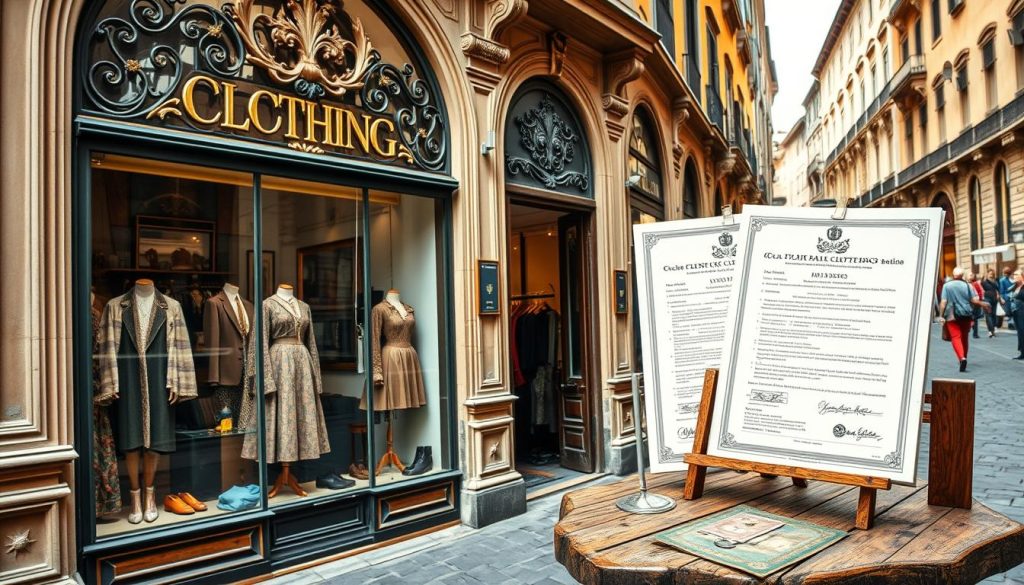
Starting a vintage clothing store in Milan means you must know the legal rules. Registering your business in Italy is the first step. It involves many official tasks to run your business legally. Knowing the Italian business laws helps you start smoothly.
Registering Your Business
The business registration process in Italy has several steps:
- Decide on a business type, like being a sole trader or a partnership.
- Get a VAT number for tax reasons.
- Register with the Chamber of Commerce.
- Open a business bank account for managing money.
Each step is important for setting up a legal business in Milan.
Understanding Italian Business Laws
Knowing Italian business laws also helps. Important things to consider are:
- Following health and safety rules.
- Keeping to consumer protection laws.
- Knowing the taxes you need to pay based on your business type.
Understanding these laws reduces risks. It helps your boutique stay legal and succeed in Milan.
Sourcing Quality Vintage Clothing

Finding vintage clothes needs careful thought. It’s important to ensure the clothes are stylish and of good quality. Working with reliable suppliers in Italy is key. Good sourcing can improve your stock and reputation.
Finding Reliable Suppliers
Finding good suppliers is crucial. Here are some tips:
- Network with industry experts for tips and advice.
- Go to vintage fairs and expos to meet suppliers face-to-face.
- Use online directories to find trusted wholesalers.
- Do thorough checks to make sure suppliers are trustworthy.
These steps help you build strong relationships with reliable suppliers. This ensures you get quality items regularly.
The Importance of Authenticity in Vintage Clothing
Being honest about vintage clothing is vital. It builds trust with customers. Here’s how to keep your store’s items genuine:
- Study historical labels and tags to check if they’re real.
- Look for special marks or features that show a piece’s age.
- Train your staff to spot fake items.
- Provide certificates of authenticity for expensive items.
Being open about your items’ authenticity boosts your store’s reputation. It also encourages customers to come back.
Creating an Inviting Store Atmosphere

Making your vintage store welcoming can boost sales and customer engagement. The right design is key to creating a space that feels inviting. Here are some tips for enhancing your store’s interior with thoughtful design and visual merchandising.
Interior Design Tips for Vintage Stores
A vintage store’s interior should evoke nostalgia and charm. Here are some tips to make your space captivating:
- Incorporate vintage furniture and fixtures to complement the clothing.
- Use warm lighting to enhance the overall ambience.
- Select a colour palette that reflects the vintage style, such as muted pastels or rich jewel tones.
- Feature unique decor items like antique mirrors or retro signage to draw attention.
- Design distinct zones within the store for different aesthetic themes, allowing for a varied shopping experience.
The Role of Visual Merchandising
Effective visual merchandising can greatly impact how customers view your products. Consider these elements to enhance your store:
- Organise clothing by style, era, or colour to create an aesthetically pleasing display.
- Utilise mannequins to showcase outfits and inspire customer purchases.
- Incorporate props that tell a story or evoke a particular period to create an immersive experience.
- Pay attention to foot traffic flow, ensuring that your layout encourages exploration and interaction.
- Regularly update displays to maintain customer interest and reflect seasonal changes.
Marketing Your Vintage Clothing Store
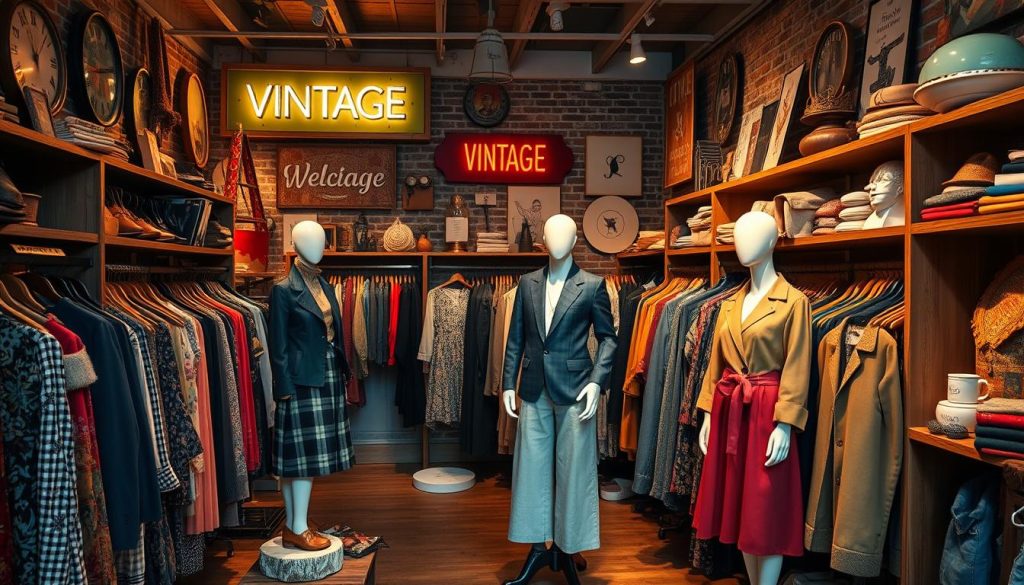
Marketing is key for a vintage store’s success. Social media is a powerful tool to boost your brand. Instagram and Pinterest are great for showing off unique items and connecting with customers. They help build a lively online community.
Using beautiful images and stories about each item can make your marketing shine.
Utilising Social Media Platforms
To make the most of social media, follow these tips:
- Make your feed look good to attract followers.
- Post often to keep your audience interested.
- Share stories and reels for behind-the-scenes looks and tips.
- Use hashtags to reach more people who love vintage fashion.
Collaborating with Local Influencers
Working with influencers can help you reach more people and build trust. Local influencers can bring new customers to your store. Here’s how to collaborate:
- Host events or pop-up shops together.
- Give influencers items to review or style.
- Ask influencers to share their favourite items on social media.
By using social media well and teaming up with influencers, your store can get more noticed and sell more.
Building a Strong Brand Identity

Creating a strong brand identity is key for any vintage clothing store. It shows what the store is all about and connects with its audience. A good visual look can make customers loyal and easily recognisable. This part talks about two main parts of brand identity: picking a catchy store name and designing eye-catching visuals.
Choosing a Memorable Store Name
A great store name is the base of your brand’s identity. It should be unique, simple to say, and match the vintage vibe. Here are some tips for picking a name that grabs attention:
- Think of names that bring back memories or match the style of clothes you sell.
- Ensure the name is simple to spell and find online.
- Get feedback from friends and family to see how they react.
Designing Your Logo and Visual Elements
Your logo should show what your store is all about. A good logo can make your brand stand out in a busy market. Key things include:
- Picking colours that fit the vintage look.
- Using fonts that match your store’s theme.
- Adding symbols that highlight what makes your store special.
Customer Engagement Strategies

Building loyalty and a thriving community in a vintage store is key. Engaging customers through meaningful experiences can create lasting relationships. It also drives more people to visit the store. Creative events and a strong loyalty programme can boost customer satisfaction and repeat visits.
Hosting Events and Workshops
Organising events and workshops tailored to your audience can attract new customers. It also creates a sense of community. Examples of engaging activities include:
- Fashion shows featuring local models in your vintage collections.
- Workshops on upcycling vintage clothing, appealing to sustainability-minded shoppers.
- Guest speakers who share insights on vintage fashion trends and styles.
- Collaborative events with local artists, enhancing the store’s cultural ties.
Such events not only draw attention to the store but also make it a hub for vintage fashion enthusiasts. Promoting these events on social media can increase reach and participation.
Creating a Loyalty Program
Developing a loyalty programme rewards repeat customers and encourages more purchases. This strategy strengthens customer engagement at your vintage store. Consider these loyalty programme ideas:
- Points system where customers earn points for every purchase, redeemable against future shopping.
- Exclusive access to private sales or early bird discounts for loyal members.
- Birthday discounts as a personalised touch, making clients feel valued.
- Member-exclusive events, enhancing the sense of belonging within the vintage community.
Effective customer engagement through events and loyalty programmes can improve visibility and customer retention. Such strategies make shoppers feel appreciated, helping your business grow.
Pricing Your Vintage Clothing Effectively
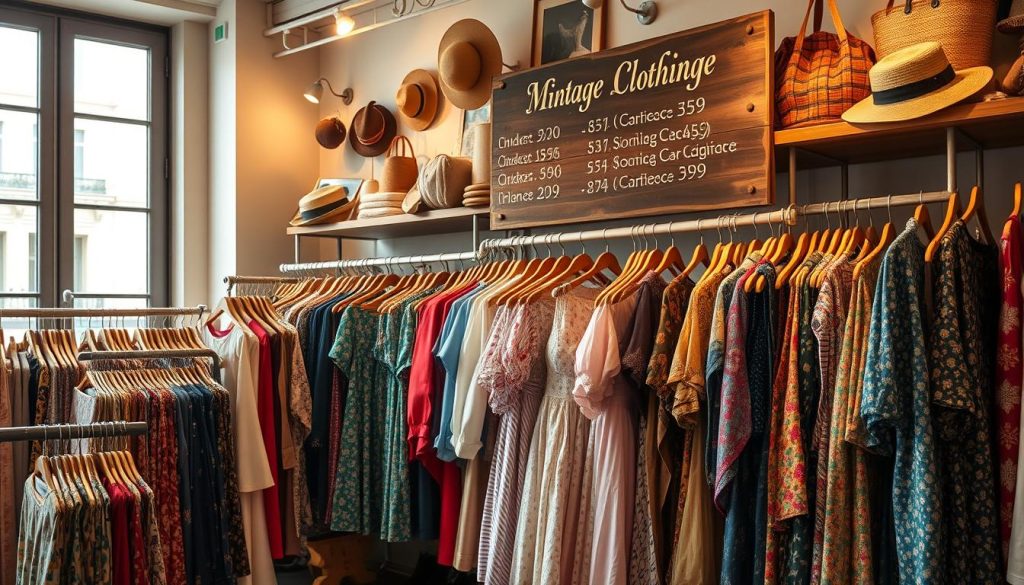
Setting the right price for vintage clothing is key. It’s about knowing the market well. Owners need to look at what similar items are selling for. This helps set prices that match quality and demand, staying competitive.
Understanding Market Prices
To understand market prices, follow these steps:
- Look at what local shops charge.
- Check online prices to see what’s common.
- Think about how rare and in good condition the items are. These things really affect price.
With this knowledge, owners can price their items in a way that appeals to their customers.
Setting Competitive Prices
For competitive pricing, find a balance between making money and attracting customers. Here are some tips:
- Start with prices based on your research, but be open to change.
- Keep an eye on prices and adjust as needed.
- Use sales or discounts to draw in customers when it’s slow.
By using these strategies, vintage clothing stores can grow their customer base and stay popular.
Maintaining Inventory and Stock Management

Keeping a vintage store’s inventory in check is key to success. Using top-notch stock management software helps a lot. It makes tracking inventory easier and boosts profits. This part looks at tools for managing stock and how to track sales trends for better decisions.
Using Inventory Management Software
Choosing the right stock management software for a vintage store is smart. These tools help a lot:
- They automate updates to keep inventory levels right.
- They create reports for deeper insights into stock.
- They help spot the most popular items quickly.
- They work with online shops for live inventory tracking.
How to Track Sales and Trends
Keeping an eye on sales trends is vital for making smart stock choices. Here are ways to do it well:
- Look at past sales to find busy times.
- Use sales analytics in stock software.
- Listen to what customers say to shape your stock.
- Check sales regularly to adjust stock levels.
Building Relationships with Your Customers
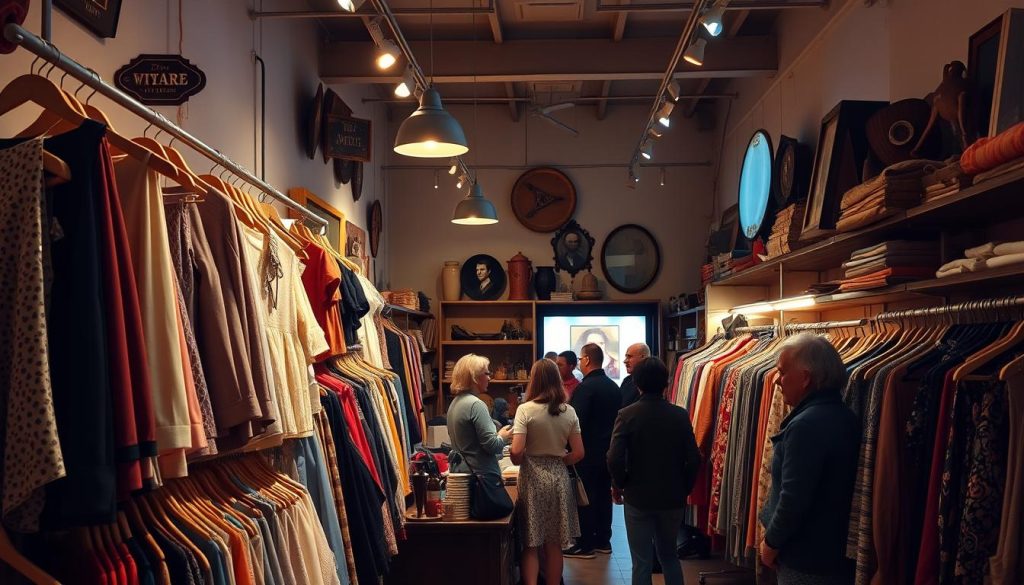
Creating strong bonds with customers is key for a vintage clothing store in Milan to thrive. Focusing on customer relationship management boosts loyalty and satisfaction. This builds a strong community around the brand. Personalised shopping experiences are vital, as they lead to memorable interactions that encourage customers to come back.
Offering Personalised Shopping Experiences
Personalised shopping experiences are crucial for building deeper connections. Tailoring the shopping journey based on customer preferences and past purchases is essential. Here are some ways to do it:
- Gather customer data through loyalty programmes and surveys.
- Use this information to recommend items that align with individual styles.
- Provide bespoke styling advice that reflects the unique tastes of customers.
These efforts improve customer engagement and satisfaction. They drive repeat visits and purchases.
Responding to Customer Feedback
Engaging with customer feedback strengthens relationships. Here’s how:
- Encourage customers to share their thoughts and experiences through social media or in-store interactions.
- Regularly review feedback to identify patterns and necessary improvements.
- Communicate changes made based on suggestions, showing that individual voices matter.
Listening and responding to feedback creates a sense of community. It makes customers feel valued and appreciated.
Staying Updated with Fashion Trends

Keeping up with the latest fashion trends is key for success in the vintage clothing world. This means getting involved in fashion weeks and trade shows, especially in Milan. Milan is known for its lively fashion scene. These events are great for seeing new designs and styles.
Also, reading industry publications focused on vintage clothing is important. They give insights into what customers want. This helps your store stay competitive and in line with changing tastes.
Following Fashion Weeks and Trade Shows
Fashion weeks in Milan are crucial for spotting new trends. By attending, store owners can see the latest from famous designers. They can also understand the market’s direction.
Going to these events is a chance to meet other industry folks. You can learn about trends that might shape your store’s choices.
Reading Industry Publications
Industry publications on vintage clothing are vital for tracking trends. By subscribing to top magazines and online sites, you get updates on fashion shifts. You’ll know what styles are popular and what customers like.
Staying informed helps you predict what’s coming in vintage fashion. This lets you adjust your stock to meet customer needs. Your store will then better match what your customers want.
Online Presence for Your Vintage Store
In today’s world, having a strong online presence is key for any vintage clothing store. This is especially true in a bustling city like Milan. A good online strategy can help your physical store and reach more customers. With more people looking for vintage clothes online, having a well-made e-commerce website is vital.
Setting Up an E-commerce Website
Choosing the right platform for your online store is crucial. Look for something that fits your brand and makes shopping easy. Shopify or WooCommerce are great options. Make sure your website shows off your vintage style with great photos and detailed descriptions.
Using Online Marketplaces Effectively
Using sites like Etsy and eBay can also help you reach more people. It’s important to know how each platform works to get the most out of it. Good management of your online presence can increase your brand’s popularity and keep customers coming back.









